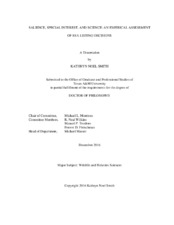| dc.contributor.advisor | Morrison, Michael L | |
| dc.creator | Smith, Kathryn Noel | |
| dc.date.accessioned | 2017-02-02T16:37:39Z | |
| dc.date.available | 2018-12-01T07:20:12Z | |
| dc.date.created | 2016-12 | |
| dc.date.issued | 2016-09-02 | |
| dc.date.submitted | December 2016 | |
| dc.identifier.uri | https://hdl.handle.net/1969.1/158699 | |
| dc.description.abstract | It is collectively understood that the best quality science is needed to inform policy decisions; however, what constitutes quality science or how much scientific evidence is needed to make an informed decision is usually unclear. The Endangered Species Act (ESA) seeks to protect plants and animals in their native habitats and the use of “best available science” is required to make decisions regarding the listing of species as endangered or threatened. To date, no comprehensive study has evaluated the interaction of “best available science” and public and private interests in the bureaucratic decision-making process within a limited period. In 2011, U.S. Fish and Wildlife Service (FWS) reached agreements to create a multi-year work plan to review 251 candidate species to determine if they should be protected by the ESA which provides a unique opportunity to evaluate listing decisions in a narrow period.
For most species evaluated under the ESA, the population and range extent were consistently unknown, and the strong influence of non-biological variables on listing decision indicate that scientific and commercial data are not the sole source of influence on likelihood of species protection. Additionally, species decisions that provided estimates on population metrics varied markedly by what population sizes constitute protection. My results indicate that species included in multi-species Rules were more likely to be protected than those evaluated on their own and likelihood of protection was much higher for species that had been on the candidate list for >10 yrs and the public directly influences bureaucratic behavior and decision quality. Other factors influencing decision quality interacted with workload, suggesting that under greater resource restrictions, bureaucrats will focus their resources on decisions that have higher potential negative feedback in order to avoid criticism. Additionally, the dynamics of listing decisions affecting public lands were different from those affecting private lands. My recommendations for improvement of ESA implementation include increased overall transparency in the listing process including what constitutes an endangered or threatened species, clarity in who is making the final decisions, and specifying which literature were the primary sources in each decision. Additionally, more funding should be allocated for candidate species research before listing decisions are made and resources should be increased for overextended regions and offices. | en |
| dc.format.mimetype | application/pdf | |
| dc.language.iso | en | |
| dc.subject | Endangered Species Act | en |
| dc.subject | ESA | en |
| dc.subject | bureaucratic decisions | en |
| dc.subject | endangered species, U.S. Fish and Wildlife Service | en |
| dc.subject | USFWS | en |
| dc.subject | bureaucratic behavior | en |
| dc.title | Salience, Special Interest, and Science: An Empirical Assessment of ESA Listing Decisions | en |
| dc.type | Thesis | en |
| thesis.degree.department | Wildlife and Fisheries Sciences | en |
| thesis.degree.discipline | Wildlife and Fisheries Sciences | en |
| thesis.degree.grantor | Texas A & M University | en |
| thesis.degree.name | Doctor of Philosophy | en |
| thesis.degree.level | Doctoral | en |
| dc.contributor.committeeMember | Wilkins, Neal | |
| dc.contributor.committeeMember | Teodoro, Manuel P | |
| dc.contributor.committeeMember | Fleischman, Forrest D | |
| dc.type.material | text | en |
| dc.date.updated | 2017-02-02T16:37:39Z | |
| local.embargo.terms | 2018-12-01 | |
| local.etdauthor.orcid | 0000-0001-6998-4317 | |


